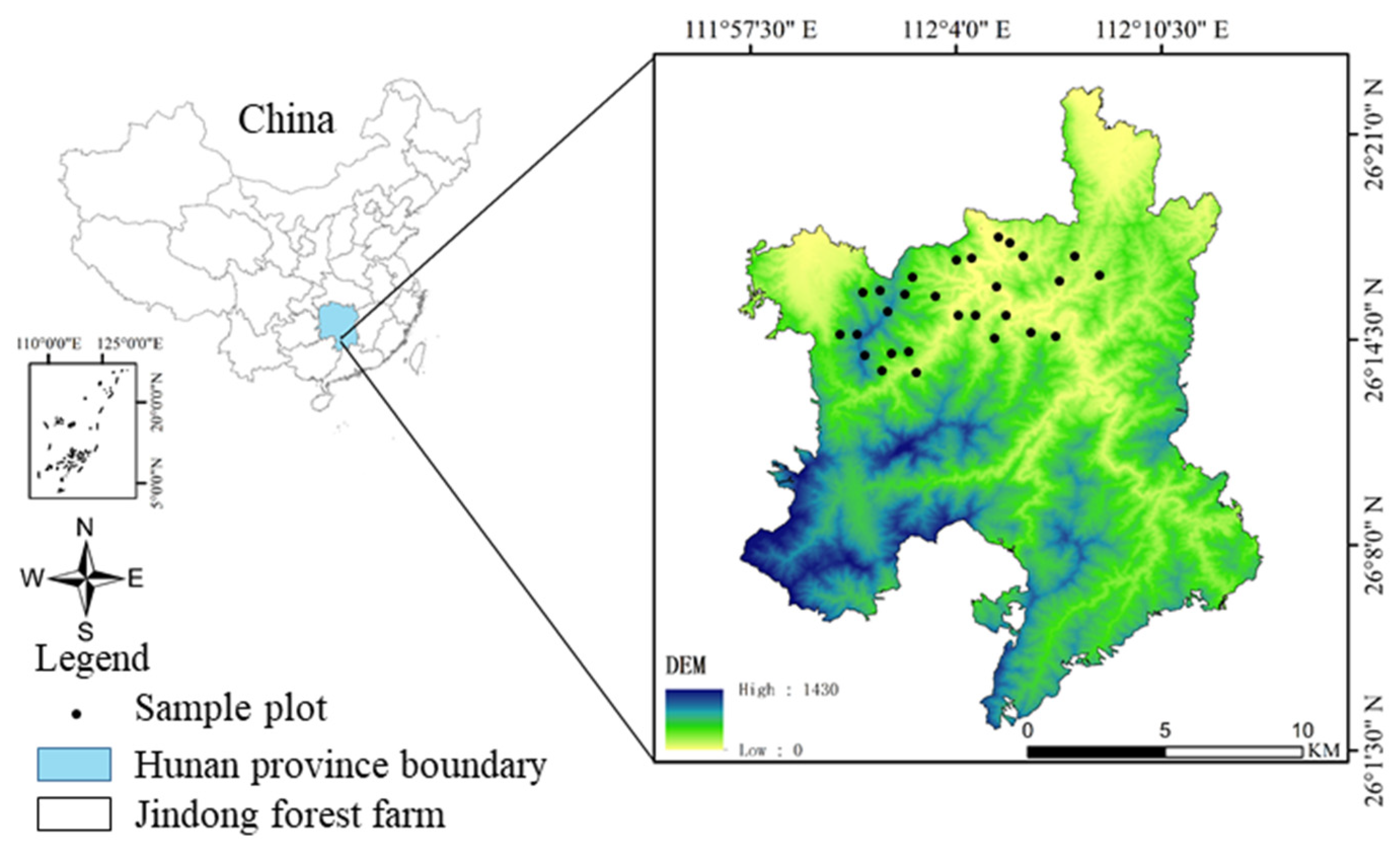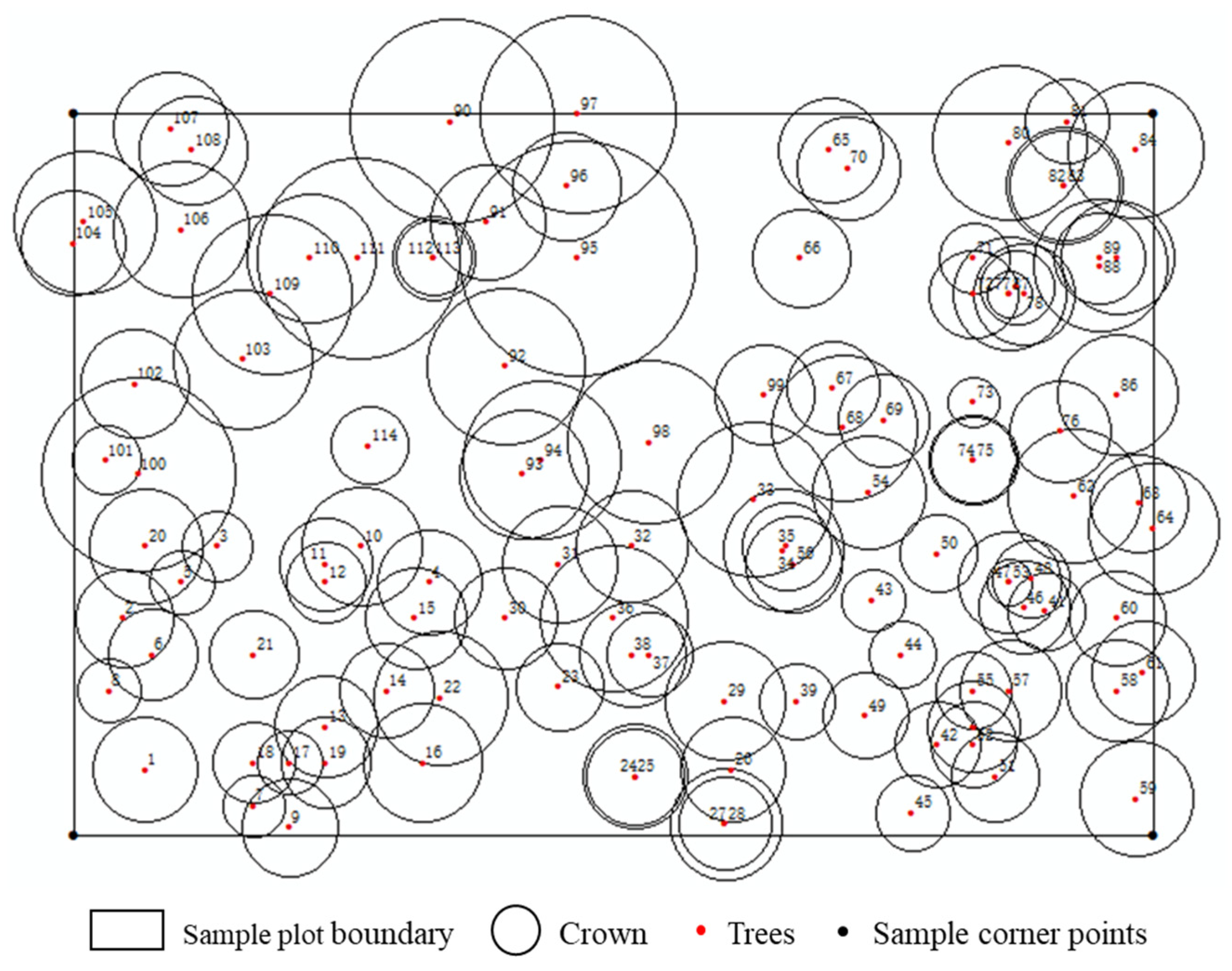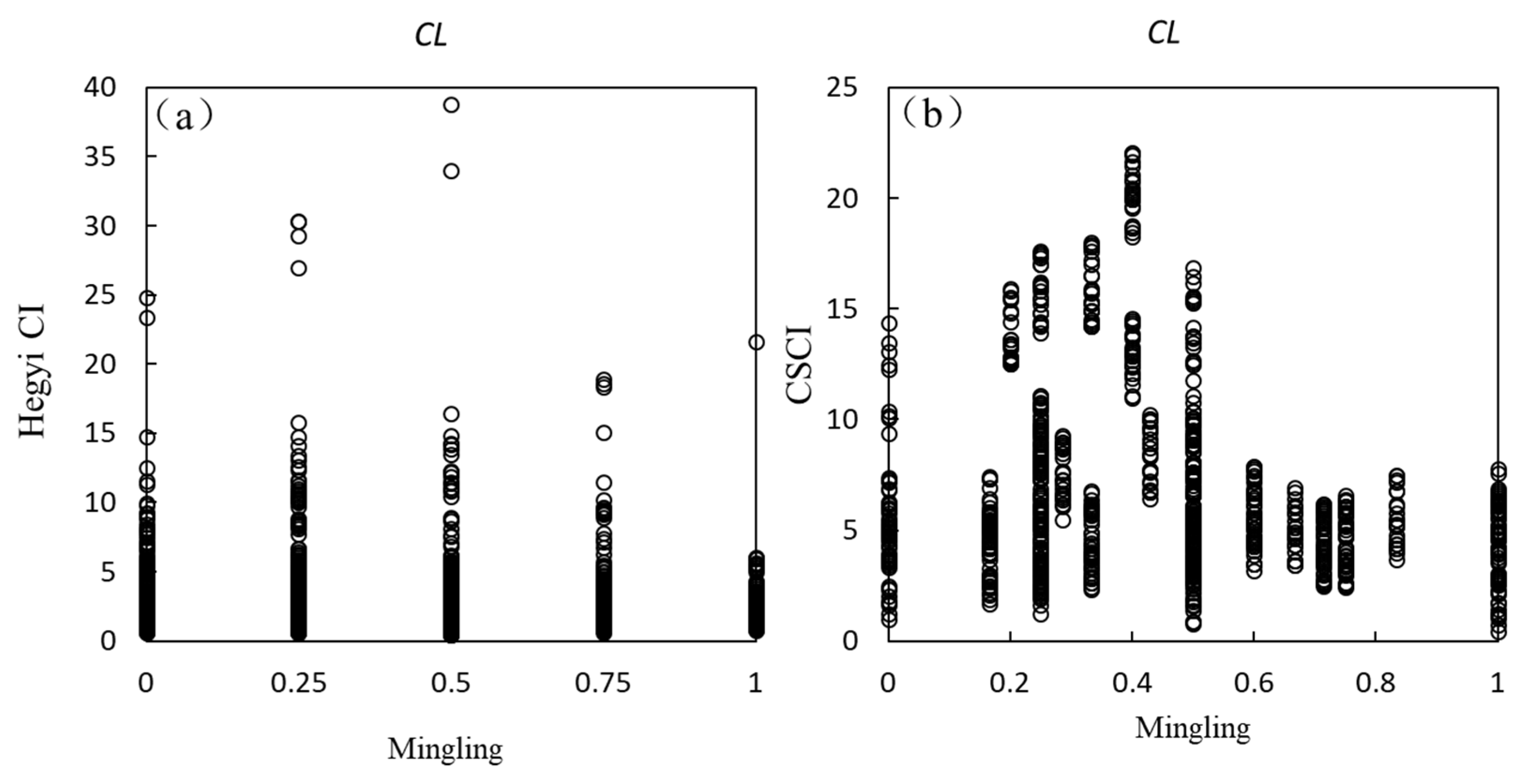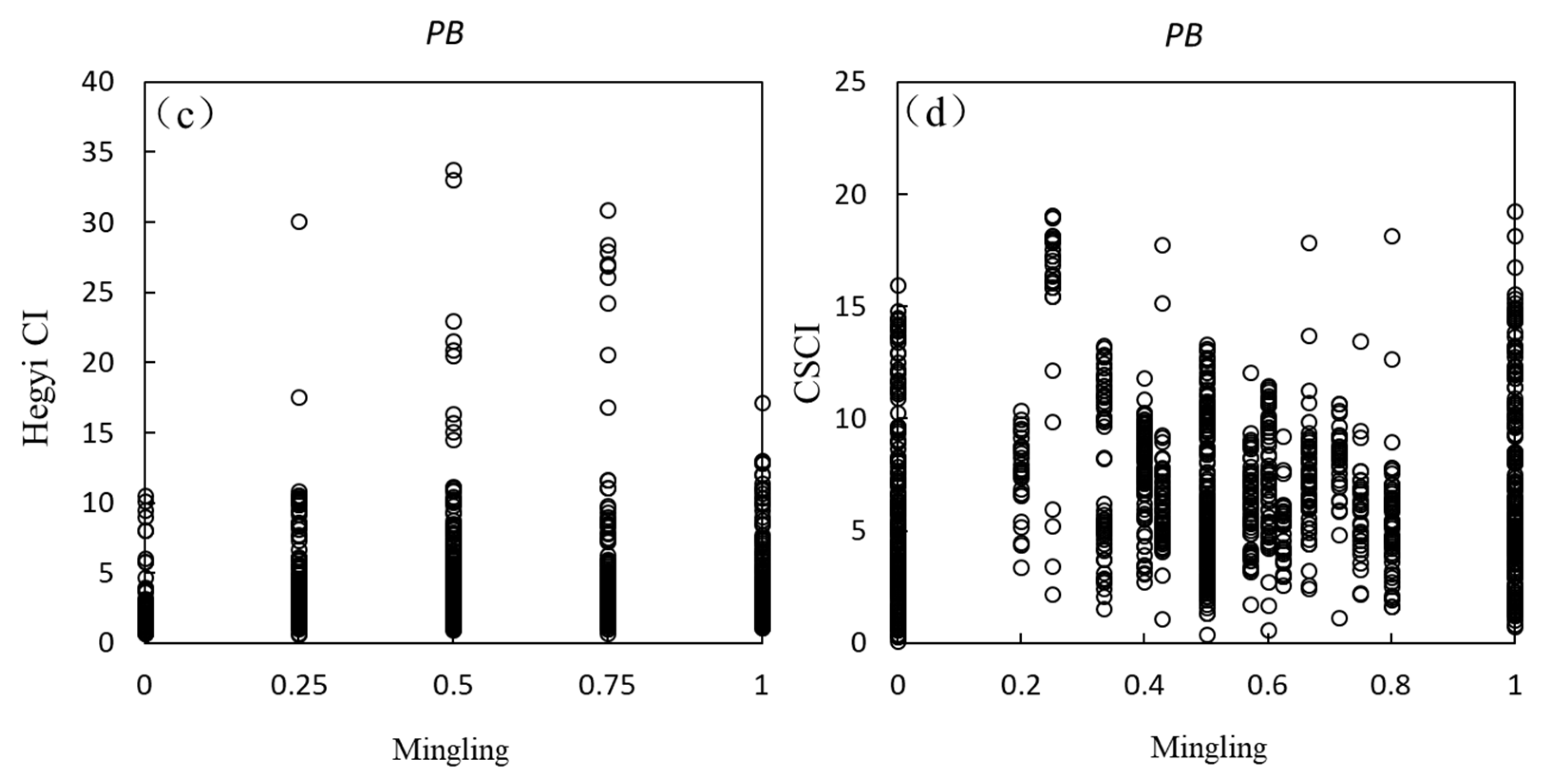Assessing the Relationship between Tree Growth, Crown Size, and Neighboring Tree Species Diversity in Mixed Coniferous and Broad Forests Using Crown Size Competition Indices
Abstract
1. Introduction
2. Materials and Methods
2.1. Study Area
2.2. Study Design and Sampling
2.3. Crown Measurement
2.4. Statistical Analysis
2.4.1. Competition Index
2.4.2. Diversity Variable
2.4.3. Annual Growth Increment
2.4.4. Inverse Distance Weighting
3. Results
3.1. Spatial Distribution of Crown Size and Competition Index
3.2. The Correlation between Tree Growth Increment and Competition Index in CLPB Mixed Forests
3.3. The Effect of Neighborhood Tree Species Diversity on Tree Competition
4. Discussion
4.1. Interactions between the Focal Tree and Their Neighboring Trees
4.2. Neighborhood Species Diversity and Tree Competition
4.3. Competition Indices
5. Conclusions
Author Contributions
Funding
Data Availability Statement
Acknowledgments
Conflicts of Interest
References
- Pagel, J.; Cooksley, H.; Schurr, F.M.; Walter, H.E.; Neu, A.; Schleuning, M. Effects of biotic interactions on plant fecundity depend on spatial and functional structure of communities and time since disturbance. J. Ecol. 2023, 111, 110–124. [Google Scholar]
- Wang, S.; Chen, H.Y. Diversity of northern plantations peaks at intermediate management intensity. For. Ecol. Manag. 2010, 260, 238. [Google Scholar] [CrossRef]
- Fibich, P. The Effects of Neighbours in Plant Communities: Mathematical and Experimental Approaches. Ph.D. Thesis, Jihočeská Univerzita v Českých Budějovicích, České Budějovice, Czechia, 2012. [Google Scholar]
- Yu, M.H.; Canham, C.D.; Peters, C.M. A neighborhood analysis: Effects of crowding on tree growth in a single-tree selectively logged forest. In Proceedings of the 94th ESA Annual Convention, Albuquerque, NM, USA, 2–7 August 2009. [Google Scholar]
- Catherine, C.; Clement, C. Using competition and light estimates to predict diameter and height growth of naturally regenerated beech seedlings growing under changing canopy conditions. Forestry 2006, 79, 489–502. [Google Scholar]
- Krůček, M.; Trochta, J.; Cibulka, M.; Král, K. Beyond the cones: How crown shape plasticity alters aboveground competition for space and light-evidence from terrestrial laser scanning. Agric. For. Meteorol. 2019, 264, 188–199. [Google Scholar] [CrossRef]
- Purves, D.W.; Lichstein, J.W.; Pacala, S.W. Crown plasticity and competition for canopy space: A new spatially implicit model parameterized for 250 north american tree species. PLoS ONE 2007, 2, e870. [Google Scholar] [CrossRef] [PubMed]
- Uria-Diez, J.; Pommerening, A. Crown plasticity in scots pine (Pinus sylvestris L.) as a strategy of adaptation to competition and environmental factors. Ecol. Model. 2017, 356, 117–126. [Google Scholar] [CrossRef]
- Vanderwel, M.C.; Lopez, E.L.; Khayyatkhoshnevis, P.; Sprott, A.H.; Shovon, T.A. Using aerial canopy data from uavs to measure the effects of neighbourhood competition on individual tree growth. For. Ecol. Manag. 2020, 461, 117949. [Google Scholar] [CrossRef]
- Pretzsch, H. Forest Dynamics, Growth and Yield: From Measurement to Model; Springer: Berlin/Heidelberg, Germany, 2009. [Google Scholar]
- Pretzsch, H.; Schütze, G. Crown allometry and growing space efficiency of norway spruce (Picea abies [L.] karst.) and european beech (Fagus sylvatica L.) in pure and mixed stands. Plant Biol. 2010, 7, 628–639. [Google Scholar] [CrossRef] [PubMed]
- Lang, A.C.; Härdtle, W.; Bruelheide, H.; Kröber, W.; Schröter, M.; von Wehrden, H.; von Oheimb, G. Horizontal, but not vertical canopy structure is related to stand functional diversity in a subtropical slope forest. Ecol. Res. 2011, 27, 181–189. [Google Scholar] [CrossRef]
- Juchheim, J.; Annighöfer, P.; Ammer, C.; Calders, K.; Raumonen, P.; Seidel, D. How management intensity and neighborhood composition affect the structure of beech (Fagus sylvatica L.) trees. Trees 2017, 31, 1723–1735. [Google Scholar] [CrossRef]
- Brisson, J. Neighborhood competition and crown asymmetry in acer saccharum. Can. J. For. Res. 2001, 31, 2151–2159. [Google Scholar] [CrossRef]
- Bohlman, S.A. Species diversity of canopy versus understory trees in a neotropical forest: Implications for forest structure, function and monitoring. Ecosystems 2015, 18, 658–670. [Google Scholar] [CrossRef]
- Bataineh, M.; Childs, E. Competition effects on growth and crown dimensions of shortleaf and loblolly pine in mature, natural-origin, pine–hardwood mixtures of the upper west gulf coastal plain of Arkansas, USA: A neighborhood analysis. Forests 2021, 12, 935. [Google Scholar] [CrossRef]
- Grams, T.E.E.; Daigo, M.J.; Winkler, J.B.; Gayler, S.; Matyssek, R. Growth and space use in competitive interactions between juvenile trees. Ecol. Stud. 2012, 220, 273–286. [Google Scholar]
- Rubén, M.; François, M.; François, N.; Fortin, M. Incorporating stochasticity from extreme climatic events and multi-species competition relationships into single-tree mortality models. For. Ecol. Manag. 2015, 354, 243–253. [Google Scholar]
- Zhang, C.; Zhao, X.; Gao, L.; Gadow, K.V. Gender, neighboring competition and habitat effects on the stem growth in dioecious fraxinus mandshurica trees in a northern temperate forest. Ann. For. Sci. 2009, 66, 812. [Google Scholar] [CrossRef]
- Grabarnik, P.; Särkkä, A. Modelling the spatial and space-time structure of forest stands: How to model asymmetric interaction between neighbouring trees. Procedia Environ. Sci. 2011, 7, 62–67. [Google Scholar] [CrossRef]
- Aleinikovas, M.; Linkevičius, E.; Kuliešis, A.; Rolhle, H.; Schroder, J. The impact of competition for growing space on diameter, basal area and height growth in pine trees. Balt. For. 2014, 20, 301–313. [Google Scholar]
- Fichtner, A.; Sturm, K.; Rickert, C.; Von Oheimb, G.; HäRdtle, W. Crown size-growth relationships of european beech (Fagus sylvatica L.) are driven by the interplay of disturbance intensity and inter-specific competition. For. Ecol. Manag. 2013, 302, 178–184. [Google Scholar] [CrossRef]
- Forrester, D.I.; Rodenfels, P.; Haase, J.; Hrdtle, W.; Leppert, K.N.; Niklaus, P.A.; von Oheimb, G.; Scherer-Lorenzen, M.; Bauhus, J. Tree-species interactions increase light absorption and growth in chinese subtropical mixed-species plantations. Oecologia 2019, 191, 421–432. [Google Scholar] [CrossRef]
- Qiu, J.; Tang, M.; Lou, M.; Shen, L.; Pang, C.; Zou, Y. Analysis of the spatial structure and competition with a phyllostachys edulis standbased on an improved hegyi model. Acta Ecol. Sin. 2016, 36, 1058–1065. [Google Scholar]
- Xinmin, S. A new single-tree competition measure-relative effective crown ratio. Rorest Res. 1994, 7, 337–341. [Google Scholar]
- Winter, S.; Böck, A.; Mcroberts, R.E. Estimating tree species diversity across geographic scales. Eur. J. For. Res. 2012, 131, 441–451. [Google Scholar] [CrossRef]
- Peng, W. Construction of eco-efficiency index system for preventing and controlling rocky desertification in Gangzhai karst small watershed, Kaiyang, Guizhou and system evaluation. J. Cent. South Univ. For. Technol. 2014, 34, 95–101+106. [Google Scholar] [CrossRef]
- Jun, H.Y.; Ming, L.J.; Cheng, Z.Z.; Chun, L.J.; Jing, J.; Ming, G.X. Intraspecific and interspecific competition in alsophila spinulosa community. J. Southwest Agric. Univ. 2004, 26, 589–593. [Google Scholar]
- Buymu, Z.; Yang, H.; Zhao, G.; Wang, L. Progress in the study of single-tree competition index. J. Northwest Coll. For. 2012, 27, 152–158. [Google Scholar]
- Guan, Y.X.; Zhang, S.T. Classification and Evaluation of Competition Indicators. J. Beijing For. Univ. 1992, 1–8. [Google Scholar]
- Yang, H.B.; Guo, Q.X. Influence of topography and competitive factors on the relationship between DBH and age of Korean pine. Acta Ecol. Sin. 2016, 36, 6487–6495. [Google Scholar]
- Chi, X.; Tang, Z.; Xie, Z.; Guo, Q.; Zhang, M.; Ge, J.; Xiong, G.; Fang, J. Effects of size, neighbors, and site condition on tree growth in a subtropical evergreen and deciduous broad-leaved mixed forest, China. Ecol. Evol. 2015, 5, 5149–5161. [Google Scholar] [CrossRef]
- Torresan, C.; del Río, M.; Hilmers, T.; Notarangelo, M.; Bielak, K.; Binder, F.; Boncina, A.; Bosela, M.; Forrester, D.I.; Hobi, M.L.; et al. Importance of tree species size dominance and heterogeneity on the productivity of spruce-fir-beech mountain forest stands in Europe. For. Ecol. Manag. 2020, 457, 117716. [Google Scholar] [CrossRef]
- Cai, Y.; Li, S.; Chen, C.; Zhan, B. The growth of Manglietia yuyuanensis stand mixed with Cunninghamia lanceolata and the interspecific competition between the tree species. Entia Silvae Sin. 2005, 41, 201–206. [Google Scholar]
- Hegyi, F. A simulation model for managing jack-pine stands. In: Growth models for tree and stand simulation. Stockh. R. Coll. For. 1974, 30, 74–90. [Google Scholar]
- Zhu, L.J.; Jin, G.Z.; Du, W.X.; Wang, X.C. Characteristics of canopy disturbance for a typical broadleaf-korean pine mixed forest in Xiaoxing’an mountains, Liangshui, northeastern China. J. Beijing For. Univ. 2016, 38, 17–27. [Google Scholar]
- Bella, I.E. A new competition model for individual trees. For. Sci. 1971, 17, 364–372. [Google Scholar]
- Nishimura, N. Forest community dynamics and tree competition of a secondary stand dominated by pine-broad leaved tree in kaisho forest. Bull. Inst. Environ. Manag. 2008, 7, 11–16. [Google Scholar]
- Burrascano, S.; Keeton, W.S.; Sabatini, P.F.M.; Blasi, C. Commonality and variability in the structural attributes of moist temperate old-growth forests: A global review. For. Ecol. Manag. 2013, 291, 458–479. [Google Scholar] [CrossRef]
- Forrester, D.I. Linking forest growth with stand structure: Tree size inequality, tree growth or resource partitioning and the asymmetry of competition. For. Ecol. Manag. 2019, 447, 139–157. [Google Scholar] [CrossRef]
- Huang, X. Study on the Structure and Function of Phoebe bournei Hemsl. Yang Artificial Forest. Master’s Thesis, Central South University of Forestry Technology, Changsha, China, 2018. [Google Scholar]
- Wu, Z. Study on growth effect of the mixed forest of Cunninghamia lanceolata and Phoebe bournei. J. Fujian Coll. For. 2005, 25, 142–146. [Google Scholar] [CrossRef]
- Wang, Y.R.; Li, J.P.; Cao, X.Y.; Tang, T. Study on optimum density and mixed proportion of chinese fir and Phoebe bournei mixed forest based on species diversity. J. Cent. South Univ. For. Technol. 2019, 39, 30–37. [Google Scholar] [CrossRef]
- Hui, G. Studies on the application of stand spatial structure parameters based on the relationship of neighborhood trees. J. Beijing For. Univ. 2013, 35, 1–8. [Google Scholar] [CrossRef]
- Zhang, Y.; Zhang, H.; Chen, Y.; Li, Y.; Ma, L. Study of tree competition index based on crown feature. For. Res. 2016, 29, 80–84. [Google Scholar]
- Zhao, Z.; Hui, G.; Hu, Y.; Li, Y. Comparison of tree species diversity calculated. Sci. Silvae Sin. 2012, 48, 1–8. [Google Scholar]
- Fisher, R.A.; Williams, A.S.C.B. The relation between the number of species and the number of individuals in a random sample of an animal population. J. Anim. Ecol. 1943, 12, 42–58. [Google Scholar] [CrossRef]
- Pielou, E.C. Segregation and Symmetry in Two-Species Populations as Studied by Nearest- Neighbour Relationships. J. Ecol. 1961, 49, 255–269. [Google Scholar] [CrossRef]
- Gadow, K.V.; Füldner, K. Bestandesbeschreibung in der Forsteinrichtun. Tagungsbericht der Arbeitsgruppe Forsteinrichtung Klieken bei Dessau. Forest 1992, 30, 267–286. [Google Scholar]
- Tu, S.X. Growth characteristics and competitive intensity analysis of young mixed forests of Cedar. For. Surv. Des. 2021, 74–75+78. [Google Scholar]
- Ratcliffe, S.; Holzwarth, F.; Nadrowski, K.; Levick, S.; Wirth, C. Tree neighbourhood matters—Tree species composition drives diversity–productivity patterns in a near-natural beech forest. For. Ecol. Manag. 2015, 335, 225–234. [Google Scholar] [CrossRef]
- Luu, T.C. Competition from Neighboring Trees in Eucalyptus Monoculture and in Mixed Species Native Forest Restoration Plantations. Ph.D. Thesis, Colorado State University, Fort Collins, CO, USA, 2012. [Google Scholar]
- Chu, K.; He, H.; Chen, Q.; Cai, F.; Song, G.; Ye, J. Effects of interspecific interactions on tree growth and survival in a broadleaf red pine forest in Changbai Mountain. J. Ecol. 2022, 41, 1050–1055. [Google Scholar] [CrossRef]
- Tang, Y.; Tong, Y.W.; Han, Y.G.; Zhou, W.M.; Zhou, L.; Dai, L.M.; Yu, D.P. Effect of neighborhood competition on key tree species growth in broadleaved-Korean pine mixed forest in Changbai mountain, China. J. Appl. Ecol. 2019, 30, 1479–1486. [Google Scholar]
- Pretzsch, H. Facilitation and competition reduction in tree species mixtures in central Europe: Consequences for growth modeling and forest management. Ecol. Model. 2022, 464, 109812. [Google Scholar] [CrossRef]
- Boyden, S.; Senock, B.R. Competition and facilitation between eucalyptus and nitrogen-fixing falcataria in relation to soil fertility. Ecology 2005, 86, 992–1001. [Google Scholar] [CrossRef]
- Barbier, S.; Gosselin, F.; Balandier, P. Influence of tree species on understory vegetation diversity and mechanisms involved—A critical review for temperate and boreal forests. For. Ecol. Manag. 2008, 254, 1–15. [Google Scholar] [CrossRef]
- Ratcliffe, S.; Wirth, C.; Jucker, T.; van der Plas, F.; Scherer-Lorenzen, M.; Verheyen, K.; Baeten, L. Biodiversity and ecosystem functioning relations in European forests depend on environmental context. Ecol. Lett. 2017, 20, 1414–1426. [Google Scholar] [CrossRef] [PubMed]
- Ruiz-Benito, P.; Gómez-Aparicio, L.; Paquette, A.; Messier, C.; Kattge, J. Diversity increases carbon storage and tree productivity in Spanish forests. Glob. Ecol. Biogeogr. 2014, 23, 311–322. [Google Scholar] [CrossRef]
- Garcia, E.; Rodriguez, M.; Lopez, S. Broadleaved species exert a greater influence on focal tree competition compared to coniferous species in European mixed forests. Eur. J. For. Res. 2020, 139, 577–589. [Google Scholar]
- Wang, Y.; Liu, Z.; Tang, T.; Li, J. Analysis of the Relative Importance of Stand Structure and Site Condtions for the Productivity, Species Diversity, and Carbon Sequestration of Cunninghamia lanceolata and Phoebe bournei Mixed Forest. Plants 2023, 12, 1633. [Google Scholar] [CrossRef]








| Specise | Number of Trees | Average DBH (cm) | Average H (m) | Average CW (m) | Average CL (m) | Average UBH (m) |
|---|---|---|---|---|---|---|
| CL | 1719 | 13.12 (5.0–27.3) | 9.40 (3.1–17.3) | 2.43 (0.2–6.6) | 6.24 (0.2–13.8) | 3.79 (0.3–10.3) |
| PB | 1171 | 9.60 (5.0–22.5) | 8.70 (2.0–16.6) | 2.48 (0.4–5.6) | 5.77 (0.2–12.8) | 2.59 (0.2–8.2) |
| CC | 58 | 10.38 (5.0–25.5) | 8.30 (4.1–13.4) | 2.29 (0.6–4.5) | 5.85 (2.2–10.8) | 2.71 (0.8–6.5) |
| SS | 43 | 8.89 (5.0–16.2) | 8.20 (5.3–10.4) | 2.28 (0.8–3.4) | 6.06 (4.6–8.6) | 2.12 (0.7–3.8) |
| Other broadleaf | 17 | 7.99 (5.2–12.0) | 6.50 (1.8–9.8) | 2.61 (0.5–5.6) | 4.60 (1.3–6.1) | 1.91 (0.5–3.9) |
| The Number of Neighboring Trees | The Number of Corresponding Focal Trees | Proportion (%) |
|---|---|---|
| 0 | 5 | 4.39 |
| 1 | 4 | 3.51 |
| 2 | 20 | 17.54 |
| 3 | 14 | 12.28 |
| 4 | 26 | 22.81 |
| 5 | 20 | 17.54 |
| 6 | 12 | 10.53 |
| 7 | 9 | 7.89 |
| 8 | 4 | 3.51 |
| Tree Species | Hegyi CI | CSCI | ||||||
|---|---|---|---|---|---|---|---|---|
| Mean | SD | Max | Min | Mean | SD | Max | Min | |
| CL | 3.99 | 25.93 | 26.58 | 0.76 | 4.03 | 13.47 | 15.18 | 0.00 |
| PB | 5.09 | 23.17 | 21.53 | 1.17 | 4.69 | 11.45 | 15.24 | 0.00 |
| Tree Species | Annual Growth Increment | CW | CL | Hegyi CI | CSCI |
|---|---|---|---|---|---|
| CL | DBH | 0.436 ** | 0.350 ** | −0.707 ** | −0.728 ** |
| Height | 0.339 ** | 0.443 ** | −0.467 ** | −0.475 ** | |
| PB | DBH | 0.498 ** | 0.562 ** | −0.556 ** | 0.654 ** |
| Height | 0.427 ** | 0.565 ** | −0.485 ** | −0.551 ** |
| Tree Species | Correlation Coefficient | Crown Size Competition Index | Hegyi Competition Index |
|---|---|---|---|
| Cunninghamia lanceolata | Kendall’s tau-b | −0.535 ** | −0.278 ** |
| Spearman’s rho | −0.700 ** | −0.395 ** | |
| Pearson | −0.494 ** | −0.416 ** | |
| Phoebe bournei | Kendall’s tau-b | −0.601 ** | −0.374 ** |
| Spearman’s rho | −0.790 ** | −0.525 ** | |
| Pearson | −0.493 ** | −0.490 ** |
Disclaimer/Publisher’s Note: The statements, opinions and data contained in all publications are solely those of the individual author(s) and contributor(s) and not of MDPI and/or the editor(s). MDPI and/or the editor(s) disclaim responsibility for any injury to people or property resulting from any ideas, methods, instructions or products referred to in the content. |
© 2024 by the authors. Licensee MDPI, Basel, Switzerland. This article is an open access article distributed under the terms and conditions of the Creative Commons Attribution (CC BY) license (https://creativecommons.org/licenses/by/4.0/).
Share and Cite
Wang, Y.; Liu, Z.; Li, J.; Cao, X.; Lv, Y. Assessing the Relationship between Tree Growth, Crown Size, and Neighboring Tree Species Diversity in Mixed Coniferous and Broad Forests Using Crown Size Competition Indices. Forests 2024, 15, 633. https://doi.org/10.3390/f15040633
Wang Y, Liu Z, Li J, Cao X, Lv Y. Assessing the Relationship between Tree Growth, Crown Size, and Neighboring Tree Species Diversity in Mixed Coniferous and Broad Forests Using Crown Size Competition Indices. Forests. 2024; 15(4):633. https://doi.org/10.3390/f15040633
Chicago/Turabian StyleWang, Yiru, Zhaohua Liu, Jiping Li, Xiaoyu Cao, and Yong Lv. 2024. "Assessing the Relationship between Tree Growth, Crown Size, and Neighboring Tree Species Diversity in Mixed Coniferous and Broad Forests Using Crown Size Competition Indices" Forests 15, no. 4: 633. https://doi.org/10.3390/f15040633
APA StyleWang, Y., Liu, Z., Li, J., Cao, X., & Lv, Y. (2024). Assessing the Relationship between Tree Growth, Crown Size, and Neighboring Tree Species Diversity in Mixed Coniferous and Broad Forests Using Crown Size Competition Indices. Forests, 15(4), 633. https://doi.org/10.3390/f15040633






